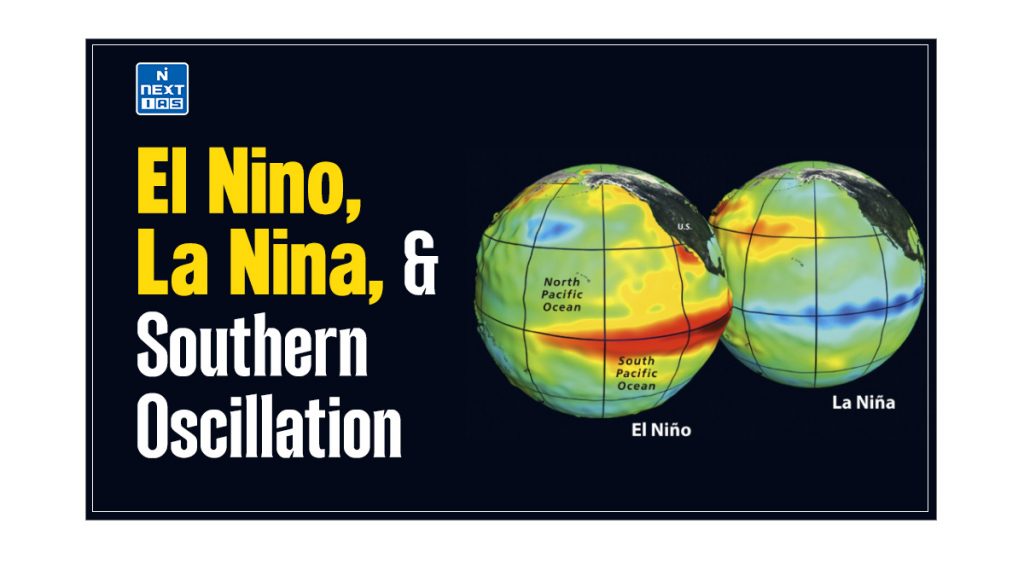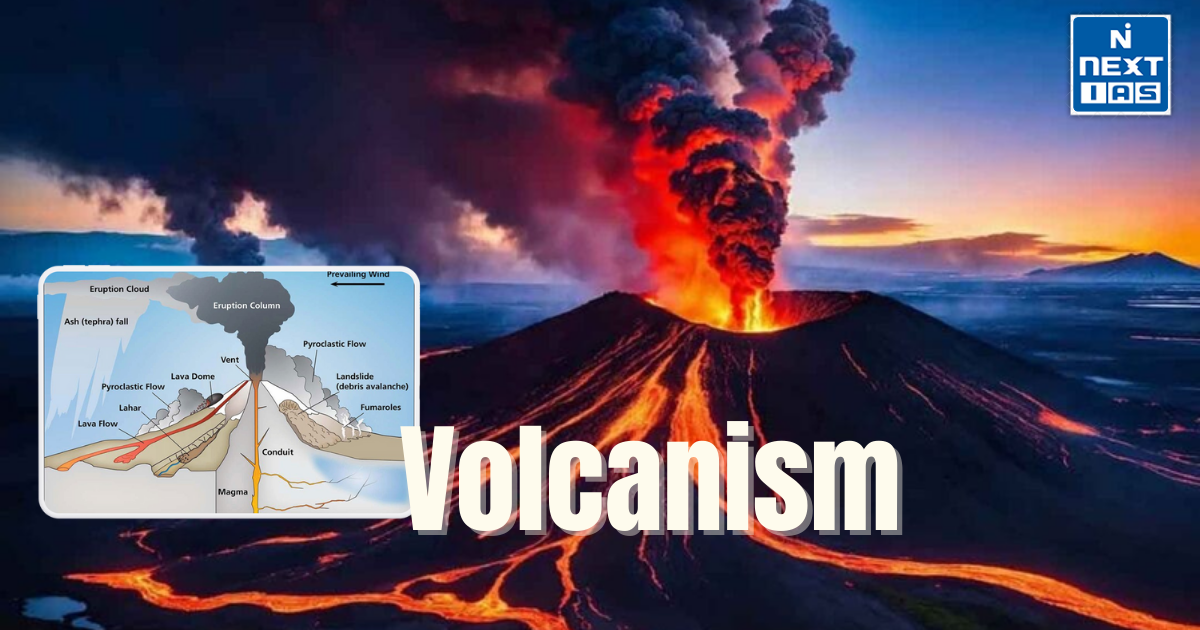
The Indian monsoon, traditionally understood as a result of differential heating of land and sea, is now recognised as a global phenomenon influenced by various large-scale climate patterns. Key among these are El Nino, La Niña, and the Southern Oscillation (ENSO), which play critical roles in global weather systems and climate variability. This article delves into the complexities of these climate patterns and their profound effects on global weather, particularly on the Indian monsoon.
About Global Weather Disturbances
- The Indian monsoon is not merely differential and local heating of land and sea, as suggested by traditional theories, but instead, it is a global phenomenon.
- Understanding various phenomena, such as El Nino and La Nina, the Indian Ocean Dipole, etc., and their contribution to global climate variability has reinforced this concept.
- For example, the Indian monsoon is strongly associated with El Nino and the Southern Oscillation (ENSO) events through ocean-atmosphere interactions.
- It is also known that the monsoon exhibits variability even on interdecadal time scales in association with other global climate variables.
- The study of such phenomena has helped in the accurate prediction of monsoonal rainfall in India. It is also essential for other parts of the globe because of the monsoon’s relation with such components.
Read our detailed article on the Indian Ocean Dipole (IOD).
El-Nino
- The term El-Nino, meaning “Christ Child,” was introduced by fishermen from Ecuador and Peru to describe the warming of the central and eastern Pacific Ocean.
- It refers to the periodic rise in sea surface temperatures along the coasts of Ecuador and Peru.
- El-Nino events are irregular, occurring every 2 to 7 years, with an average frequency of about once every 3 to 4 years.
- When this warming occurs, the typical upwelling of cold, nutrient-rich deep ocean water is greatly diminished.
- El Nino typically begins around Christmas and persists for a few weeks to a few months.
- Occasionally, exceptionally warm events can occur, lasting much longer.
- For example, in the 1990s, notable El-Nino events emerged in 1991, lasting until 1995, and from the fall of 1997 to the spring of 1998.
Normal Conditions
- In a typical year, a surface low-pressure system forms over northern Australia and Indonesia, while a high-pressure system sets up over the coast of Peru.
- Consequently, the trade winds across the Pacific Ocean blow strongly from east to west.
- This easterly wind flow moves warm surface waters westward, resulting in convective storms (thunderstorms) over Indonesia and coastal Australia.
- Meanwhile, cold, nutrient-rich water from the depths rises to the surface along the coast of Peru, replacing the warm water that has been displaced westward.

Walker Circulation (Occurs During Normal Years)
- The Walker circulation (or Walker cell) is driven by the pressure gradient force created by a high-pressure system over the eastern Pacific Ocean and a low-pressure system over Indonesia.
- A cross-section of the Pacific Ocean along the equator shows the typical atmospheric circulation pattern in the equatorial Pacific.
- The thermocline, a temperature gradient in a body of water that separates layers of different temperatures, is a key feature.
- The Walker cell is indirectly related to upwelling off the coasts of Peru and Ecuador, which brings nutrient-rich cold water to the surface and thereby boosts fishing stocks.

During El-Nino Year
- In an El-Nino year, air pressure drops over large areas of the central Pacific and South America’s coast.
- In such cases, the typical low-pressure system in the western Pacific is replaced by a weaker high-pressure system known as the Southern Oscillation.
- This alteration in the pressure pattern weakens the trade winds, leading to the formation of a Weak Walker Cell.
- Occasionally, the Walker Cell may even reverse direction. This weakening allows the equatorial countercurrent to gather warm ocean water along the coasts of Peru and Ecuador.
- Consequently, this warm water accumulation causes the thermocline to descend in the eastern Pacific, disrupting the upwelling of cold deep ocean water along the Peruvian coast.
Effects of El Nino
- The elevated water temperatures severely impact marine life along the coasts of Peru and Ecuador.
- As a result, fish catches in South American waters declined compared to typical years due to the lack of upwelling.
- This phenomenon also causes intense droughts in regions such as Australia, Indonesia, India, and southern Africa.
- Conversely, it leads to heavy rainfall in places like California, Ecuador, and the Gulf of Mexico and triggers convective storms and hurricanes in the central Pacific.
Ways in which El-Nino Impacts Monsoon Rainfall in India
- El Niño and the Indian monsoons have an inverse relationship. Six of the major droughts in India since 1871 have been associated with El Niño events, including notable ones in 2002 and 2009.
- However, not every El Niño year leads to drought in India.
- For example, despite the strong El Niño of 1997/98, no drought occurred due to mitigating factors like the Indian Ocean Dipole (IOD).
- Conversely, a moderate El Niño in 2002 contributed to one of the most severe droughts on record.
- El Niño significantly affects India’s agrarian economy by reducing the yields of summer crops such as rice, sugarcane, cotton, and oilseeds, which, in turn, impacts the nation’s GDP.
El-Nino Southern Oscillation (ENSO)
- El-Nino, combined with the Walker Circulation or Southern Oscillation, is called El-Nino Southern Oscillation (ENSO), as they are closely linked.
- The system encompasses both oceanic and atmospheric phenomena, featuring warm currents off the coast of Peru in the Eastern Pacific that influence weather patterns globally, including in India.
- El Niño represents an extension of the warm equatorial current, which temporarily displaces the cold Peruvian or Humboldt current.
- This shift leads to a temperature increase of approximately 10°C in the waters off the Peruvian coast. This results in:
- The distortion of equatorial atmospheric circulation.
- Irregularities in the evaporation of seawater.
- Reduction in the number of plankton further reduces the number of fish in the sea.
Impact of ENSO on Indian Monsoon
- This phenomenon affects rainfall in India during the Monsoon months.
- Trade winds usually blow westwards from South America towards Asia during the Indian monsoon months.
- A warming of the Pacific weakens these winds.
- The weakening of winds leads to a slowdown of upwelling on the South American coast.
- Thus, low-pressure conditions (due to warm water) prevail over the South American coast.
- Here, warm air rises upward and becomes unstable. This rising air in the east Pacific cools above and turns westward in the troposphere, ultimately descending into the tropical west Pacific.
- This gives birth to high pressure, which drives warm air towards the coast of South America.
- Moisture and heat content are limited, resulting in reduced and uneven rainfall distribution across the Indian subcontinent.

El-Nino Modoki
- El-Nino Modoki is a coupled ocean-atmosphere phenomenon in the tropical Pacific.
- Unlike conventional El-Nino, characterized by strong anomalous warming in the eastern equatorial Pacific, El-Nino Modoki is associated with anomalous warming in the central tropical Pacific and cooling in the eastern and western tropical Pacific.

Impact of El-Nino Modoki on Indian Monsoon
The impact of El-Nino Modoki includes:
- Zonal Gradients – This phenomenon results in anomalous two-cell Walker Circulation over the tropical Pacific, with a wet region in the central Pacific.
- Central Pacific Storms – El-Nino Modoki will increase storm frequency in the Central Pacific and the potential for landfall along the Gulf Coast and Central America.
- Cyclones – Compared to the general phenomenon, the Arabian Sea experiences more cyclones during pre and post-monsoon seasons. Conversely, the Bay of Bengal experiences more cyclones during the pre-monsoon and post-monsoon periods.
La Nina
- La Niña is a climate pattern characterised by the cooling of surface ocean waters along the tropical west coast of South America, resulting in a cooler surface in the eastern Pacific.
- This phenomenon occurs when the easterly trade winds strengthen and blow more warm water westward, allowing cold water below the sea’s surface to rise towards the top near the South American coast to replace the warm water.
- El Nino occurs when the easterly trade winds weaken and sometimes blow in the opposite direction. This results in the Pacific Ocean becoming warm, gaining heat, and pushing eastward.
Impact of La Niña
- Droughts in South America.
- Heavy rainfall and floods in eastern Australia.
- It supports the Indian monsoon, bringing good rain to India.
Conclusion
In summary, El Nino and La Niña represent opposing phases of the broader Southern Oscillation system, each with significant implications for global weather patterns. El Nino is marked by warming in the central and eastern Pacific, disrupting normal weather patterns and leading to droughts and floods across different regions. Conversely, La Niña brings about cooler oceanic conditions, often resulting in increased rainfall in areas such as Australia and supporting the Indian monsoon. El-Nino Modoki, a variant of El-Nino, introduces additional complexity with its unique warming patterns, affecting storm frequency and cyclone activity in various regions.
Frequently Asked Questions (FAQs)
What does El Nino mean?
El Niño is a climate phenomenon characterised by the periodic warming of sea surface temperatures in the central and eastern equatorial Pacific Ocean, which can disrupt global weather patterns, including altering precipitation and temperature patterns.
How does El Nino affect the Indian economy?
El Niño affects the Indian economy by disrupting the monsoon season, and reducing rainfall. This can result in lower agricultural yields, increased food prices, water shortages, and overall economic instability, particularly impacting sectors reliant on agriculture and water resources.
What is the main difference between El Niño and La Niña?
The main difference between El Niño and La Niña is the sea surface temperatures in the central and eastern Pacific Oceans.
– El Niño is characterized by warmer-than-average sea surface temperatures, which can lead to increased rainfall in the eastern Pacific and droughts in the western Pacific and Indian subcontinent.
– La Niña, on the other hand, is characterized by cooler-than-average sea surface temperatures, which typically result in opposite weather patterns, such as increased rainfall in the western Pacific and drier conditions in the eastern Pacific.






